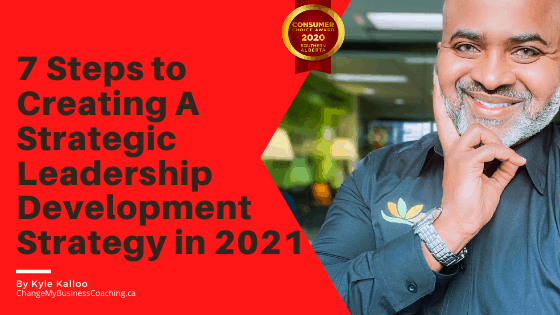7 Steps to Creating A Strategic Leadership Development Strategy in 2021
- Written by Kyle Kalloo

Table of Contents
- Tip #1 – Identify the challenges and objectives of the organization.
- Tip #2 – Identify the consequences for not improving leadership.
- Tip #3 – Build a vision and mission of strategic leadership development.
- Tip #4 – Build a list of 2-3-year priorities for strategic leadership development.
- Tip #5 – For each target, establish initiatives and action plans.
- Tip #6 – Build a structure of leadership competency.
- Tip #7 – Examination for verification and adjustment with key stakeholders.
- The Bottom Line
Note: This article contains 1,231 words, with an estimated read time of 5 minutes.
As a leadership and management consultant, I’m finding that very few people have had the opportunity to deliberately create their own unique leadership and management development strategy. Failing to do so leads to the leader or manager getting burnt out with too many conflicting priorities. I’m curious if developing a leadership and management strategy is something you have done deliberately?
Below are some tips I suggest would up your game for 2021 regardless of your position within the organization.

Tip #1 – Identify the challenges and objectives of the organization.
Creating strategic leadership and managing a bunch of systems and processes is the degree to which the corporate plan is closely connected to everything. It’s important that you do research into the organization’s literature; business plan, annual reports, corporate communications on mission/vision and goals. Then execute a round of executive interviews until you have a strong base.
Start with the CEO, if necessary, and speak to any executive team member. To save time and foster discussion, this could be done in groups, but I prefer individual discussions. When you are new to an organisation, it’s a good way to establish trust and relationships. Depending on your position in the organization, you might not have access to the senior leadership team, therefore start with your direct manager/leaders. Some of my preferred questions include:
- In the next 2-3 years, what is the greatest challenge facing this organization?
- What would you say is the organization number 1 priority?
- What new leadership & management competencies do you see as being more relevant in view of these challenges?
Often times, leaders are missing an opportunity to truly engage their senior leadership team during their one to one’s meetings. Instead of asking what keeps them up at night, find out what is most important in the organization and what they view as the key competencies to get more of what they want.
Tip #2 – Identify the consequences for not improving leadership.
I find leaders don’t slow down to self-reflect on the consequences when it comes to not improving their leadership skills and or the leaders in the organization. This area is critical for middle management. I get it, most leaders don’t think they need to improve their leadership – ask yourself though, would your team agree with your assertion…?
This is a fantastic conversation to have with your team and other main stakeholders in the organization, if you’re managing a team. There are several ways to do this but the fundamental question is; How does business objective “A” influence how we need to go about developing our leaders? What new skills are required? And what’s at risk if we don’t develop those leaders?
A simple example would be; a business that is projected to double its growth in the next five years by globally expanding product line “B”.
Obvious consequences for leadership growth include the need for general managers of product line B to establish and incorporate global leadership development processes and develop new global leadership competencies. It’s not always that easy, so that’s where some healthy debate and discussion will help tease out the consequences.

Tip #3 – Build a vision and mission of strategic leadership development.
This move presumes that you have a team that is responsible for the growth of leadership. A statement of vision is an aspirational summary of what the team would like to do or achieve in the future.
It is intended to serve as a concise guide for the selection of current and potential action courses. Having a clear vision can provide guidance and inspiration to a team and be the basis for setting goals and planning action. Keep in mind it needs to outline; What you do, for who, and how, in a mission statement. Everyone in the organization must understand clearly how they can create a path to this mission statement, all the way from the executive branch to the front line.
After stating your mission statement, everyone on the team should be able to answer the question; thinking of your role in the organization, how do you contribute to fulfilling our mission statement? If they don’t know, then you have an opportunity for further clarity. Everyone in the organization can contribute to the overall goals/mission/vision of the organization and MUST know how they can do that.
It places a barrier around the activities of your team and helps guide their everyday course. Here’s an example: “Our vision is to have a leadership team that is made up of best in class calibre leaders that think and act strategically at every level of the organisation. Our mission is to develop strategic leaders.”
Tip #4 – Build a list of 2-3-year priorities for strategic leadership development.
This short, concentrated list of long-term priorities discusses the effects and objectives defined in tips 1 & 2 above, and supports the vision and mission of the team. People want and are motivated by quick wins/progress. “Create a process to identify and develop global competencies in our product line B division’s general managers” will be an example of a 2-3-year target. If the priorities are too far out of reach, they won’t bother trying. Think about those 2020 goals you set 10 or 5 years ago… did you hit them as you imagined?
Tip #5 – For each target, establish initiatives and action plans.
It’s been said, if you fail to plan you plan to fail. One of the most significant and frequently overlooked elements of a strategic leadership development plan is the development and tracking of a handful of important metrics. Because you cannot manage what you don’t measure – someone way smarter than me said that too.
It’s complicated, but not impossible.
Tip #6 – Build a structure of leadership competency.
To develop a strategic leadership competence structure, the same process used for identity implications and priorities may be used. Get commitments for each initiative and actions, be clear with who is going to do what and hold them accountable to their commitments. You cannot hold people on the team accountable if they didn’t commit to anything. Competent leaders get results through accountability.
This structure can be seen as a way of aligning all of the processes and initiatives for leadership growth.
Tip #7 – Examination for verification and adjustment with key stakeholders.
It’s time for another executive round of meetings. Around 3 months later, you are turning up this time with a draught document explaining what you learned and how you are proposing to react. This is where you search for comprehension, make changes, and ask for commitment, interest, and money.
Build the structure of reviewing lessons learnt, gathering feedback, and making adjustments are key to ensuring everyone is still engaged and you are still working on the priorities that are valuable and relevant.
The Bottom Line
Engage your senior leaders. Know what’s a priority in the organization. And identify the gaps/skillset that you or the leaders have and create a plan to bridge the gap. Being a strategic leader is not just about having a strategy, it involves identifying clear tactics and creating an execution plan. As a leader of self, people, and the organization, we all have risks worth mitigating.
Should you need support in creating a Strategic Leadership Development Plan for 2021, reach out to me to explore the possibilities. Being a strategic leader requires both the right ingredients and method. We need you to be a strategic leader.
-----------------------------------
About the author: Kyle Kalloo is the Chief Executive Officer, Business Coach with Change My Life Coaching and Strategic Leader. Through his management training and experience with McDonalds, Famous Players (Paramount) and WestJet, and all of the ongoing learning and development he’s completed, Kyle has refined and perfected skills and processes and is eager to share how to execute them efficiently to help individuals and companies achieve even more of their dreams. 83% of Kyle’s business comes from referrals. https://www.changemylifecoaching.ca and https://strategicleader.ca